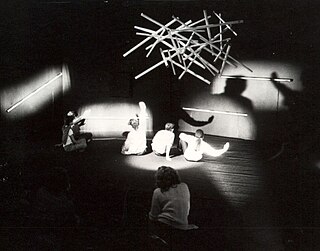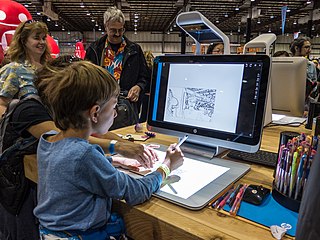Multimedia is a form of communication that combines different content forms such as text, audio, images, animations, or video into a single interactive presentation, in contrast to traditional mass media which features little to no interaction from users, such as printed material or audio recordings. Popular examples of multimedia include video podcasts, audio slideshows and animated videos.

In the industrial design field of human–computer interaction, a user interface (UI) is the space where interactions between humans and machines occur. The goal of this interaction is to allow effective operation and control of the machine from the human end, while the machine simultaneously feeds back information that aids the operators' decision-making process. Examples of this broad concept of user interfaces include the interactive aspects of computer operating systems, hand tools, heavy machinery operator controls, and process controls. The design considerations applicable when creating user interfaces are related to, or involve such disciplines as, ergonomics and psychology.

Augmented reality (AR) is an interactive experience of a real-world environment where the objects that reside in the real world are enhanced by computer-generated perceptual information, sometimes across multiple sensory modalities, including visual, auditory, haptic, somatosensory and olfactory. AR can be defined as a system that incorporates three basic features: a combination of real and virtual worlds, real-time interaction, and accurate 3D registration of virtual and real objects. The overlaid sensory information can be constructive, or destructive. This experience is seamlessly interwoven with the physical world such that it is perceived as an immersive aspect of the real environment. In this way, augmented reality alters one's ongoing perception of a real-world environment, whereas virtual reality completely replaces the user's real-world environment with a simulated one. Augmented reality is related to two largely synonymous terms: mixed reality and computer-mediated reality.

Interactive art is a form of art that involves the spectator in a way that allows the art to achieve its purpose. Some interactive art installations achieve this by letting the observer or visitor "walk" in, on, and around them; some others ask the artist or the spectators to become part of the artwork.
Computer-supported cooperative work (CSCW) is the study of how people utilize technology collaboratively, often towards a shared goal. CSCW addresses how computer systems can support collaborative activity and coordination. More specifically, the field of CSCW seeks to analyze and draw connections between currently understood human psychological and social behaviors and available collaborative tools, or groupware. Often the goal of CSCW is to help promote and utilize technology in a collaborative way, and help create new tools to succeed in that goal. These parallels allow CSCW research to inform future design patterns or assist in the development of entirely new tools.
In cognitive linguistics, conceptual blending, also called conceptual integration or view application, is a theory of cognition developed by Gilles Fauconnier and Mark Turner. According to this theory, elements and vital relations from diverse scenarios are "blended" in a subconscious process, which is assumed to be ubiquitous to everyday thought and language. Much like memetics, it is an attempt to create a unitary account of the cultural transmission of ideas.

Mixed reality (MR) is the merging of real and virtual worlds to produce new environments and visualizations, where physical and digital objects co-exist and interact in real time. Mixed reality does not exclusively take place in either the physical world or virtual world, but is a hybrid of augmented reality and virtual reality. To mark the difference: Augmented reality takes place in the physical world, with information or objects added virtually like an overlay; Virtual Reality immerses you in a fully virtual world without the intervention of the physical world.

Interactive media normally refers to products and services on digital computer-based systems which respond to the user's actions by presenting content such as text, moving image, animation, video and audio.
Multimodal interaction provides the user with multiple modes of interacting with a system. A multimodal interface provides several distinct tools for input and output of data.
Strictly, digital theatre is a hybrid art form, gaining strength from theatre’s ability to facilitate the imagination and create human connections and digital technology’s ability to extend the reach of communication and visualization.

Immersion into virtual reality (VR) is a perception of being physically present in a non-physical world. The perception is created by surrounding the user of the VR system in images, sound or other stimuli that provide an engrossing total environment.
Presence is a theoretical concept describing the extent to which media represent the world. Presence is further described by Matthew Lombard and Theresa Ditton as “an illusion that a mediated experience is not mediated." Today, it often considers the effect that people experience when they interact with a computer-mediated or computer-generated environment. The conceptualization of presence borrows from multiple fields including communication, computer science, psychology, science, engineering, philosophy, and the arts. The concept of presence accounts for a variety of computer applications and Web-based entertainment today that are developed on the fundamentals of the phenomenon, in order to give people the sense of, as Sheridan called it, “being there."
A projection augmented model is an element sometimes employed in virtual reality systems. It consists of a physical three-dimensional model onto which a computer image is projected to create a realistic looking object. Importantly, the physical model is the same geometric shape as the object that the PA model depicts.

Computational creativity is a multidisciplinary endeavour that is located at the intersection of the fields of artificial intelligence, cognitive psychology, philosophy, and the arts.
Social presence theory explores how the "sense of being with another" is influenced by digital interfaces in human-computer interactions. Developed from the foundations of interpersonal communication and symbolic interactionism, social presence theory was first formally introduced by John Short, Ederyn Williams, and Bruce Christie in The Social Psychology of Telecommunications. Research on social presence theory has recently developed to examine the efficacy of telecommunications media, including SNS communications. The theory notes that computer-based communication is lower in social presence than face-to-face communication, but different computer-based communications can affect the levels of social presence between communicators and receivers.
In computing, 3D interaction is a form of human-machine interaction where users are able to move and perform interaction in 3D space. Both human and machine process information where the physical position of elements in the 3D space is relevant.

Human–computer interaction (HCI) is research in the design and the use of computer technology, which focuses on the interfaces between people (users) and computers. HCI researchers observe the ways humans interact with computers and design technologies that allow humans to interact with computers in novel ways.
Thanatosensitivity describes an epistemological-methodological approach into technological research and design that actively seeks to integrate the facts of mortality, dying, and death into traditional user-centered design. First coined by Michael Massimi and Andrea Charise from the University of Toronto in a joint paper presented at CHI 2009, thanatosensitivity refers to a humanistically grounded approach to human–computer interaction (HCI) research and design that recognizes and engages with the conceptual and practical issues surrounding death in the creation of interactive systems.

Sprout by HP was a personal computer from HP Inc. announced on October 29, 2014 and released for sale on November 9, 2014. The system was conceived by Brad Short, a Distinguished Technologist at HP Inc., who along with Louis Kim co-founded and led a team within HP Inc. to develop and productize the computing concept. Former Apple Inc. employee, Eric Monsef, was also brought on to lead the Sprout team through a successful product launch.
New media studies is an academic discipline that explores the intersections of computing, science, the humanities, and the visual and performing arts. Janet Murray, a prominent researcher in the discipline, describes this intersection as "a single new medium of representation, the digital medium, formed by the braided interplay of technical invention and cultural expression at the end of the 20th century". The main factor in defining new media is the role the Internet plays; new media is effortlessly spread instantly. The category of new media is occupied by devices connected to the Internet, an example being a smartphone or tablet. Television and cinemas are commonly thought of as new media but are ruled out since the invention was before the time of the internet.









